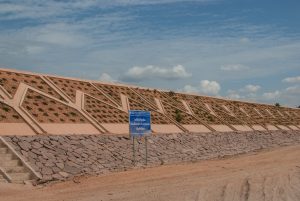Sebastian Strangio

A railway embankment in the countryside outside Vientiane, Laos, on November 12, 2018.Credit: Sebastian Strangio
The multibillion-dollar Laos-China railway is set to begin operations by the end of the year as scheduled, a Lao official said last week, completing the first link of a long-envisioned rail line connecting southwest China with Singapore.
The announcement was made by Minister of Planning and Investment Sonexay Siphandone on August 11 during a meeting of 10th Laos-China Railway Project Construction Committee, according to Pasaxon, the newspaper of the ruling Lao People’s Revolutionary Party.
Sonexay said that as of July 25, construction of the railway, which runs from the town of Boten on Laos’s border with China to the capital Vientiane, was 93.82 percent complete. “The Laos-China Railway will be completed in November, and will be open and ready for use by Laos National Day on 2 December,” he said.
Sonexay also told the meeting that Chinese operators are bringing in locomotives, electric multiple unit trains, and other equipment to conduct the first trial run of the railway in October, before opening it to the public on December 2.
An effective extension of China’s high-speed rail system into Laos, the Laos-China Railway is a striking example of Chinese technical prowess, and a headline project of Xi Jinping’s world-spanning Belt and Road Initiative (BRI). The standard gauge single-track line cuts through 417 kilometers of rugged terrain from Boten to Vientiane, including 61 kilometers of bridges and 75 tunnels with a total length of 198 kilometers.
As the Vientiane Times helpfully noted, “The Laos-China railway is a strategic part of China’s [BRI] and the Lao government’s plan to transform Laos from a landlocked country into a land link within the region.”
The fact that the railway is set to be completed on schedule testifies to the fact that despite the disruptions of the COVID-19 pandemic, Beijing remains committed to deepening the economic and physical integration between China and the nations of the lower Mekong region.
Over the past two decades, this process of integration has broken down a once-nearly impermeable barrier of mountainous terrain dividing China from mainland Southeast Asia, opening the region to a southward wave of Chinese migration and capital investment.
The impending completion of the Laos-China Railway is therefore set to bind the country of seven million people ever closer to its giant neighbor. This is true obviously in a physical sense: the railway is likely to increase the number of Chinese nationals traveling to Vientiane, which already boasts a large resident Chinese population, while boosting Chinese tourism to the former royal capital of Luang Prabang. But it is also true in a financial one.
In a 2018 report, the Washington-based Center for Global Development concluded that Laos was the one Southeast Asian country risking significant debt distress as a result of loans from China, in large part due to the railway project. A study published in 2019 by Sydney’s Lowy Institute estimated Laos’ debt to China at 45 percent of GDP.
Since both of these reports were published, the economic impacts of the COVID-19 pandemic have transformed Laos’ debt squeeze from a potential crisis to an actual one. In September of last year, due to dwindling foreign reserves, Laos was forced to cede majority control of its national power grid to a Chinese company.
I’ve tended toward skepticism on claims that China is engaged in “debt-trap diplomacy,” and that the BRI is little more than a scheme to enmesh developing nations in skeins of dependency. But there is no doubt that heavy debt burdens, whatever their source, can endanger the sovereignty of developing nations, especially in straitened economic circumstances.
No comments:
Post a Comment